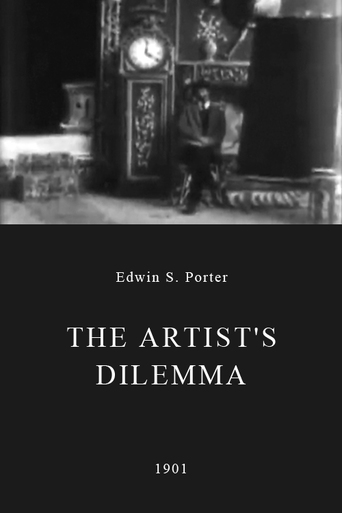Michael_Elliott
Artist's Dilemma, The (1901) *** (out of 4) Edison short which was clearly influenced by the work of Georges Melies. In the film a painter is sleeping when a woman walks out of a grandfather clock and asks him to paint her. Before he can do so a clown comes out of the clock and decides to do a magic painting. This is a pretty good magic film even though it's easy to tell how the trick is actually being done. In terms of comedy I didn't laugh much as I didn't find the clown all that funny but this really didn't take away from any of the entertainment. The main point was to enjoy the magic trick and that I did.
MartinHafer
This short film from Edison Films is very much a product of its time. The film is relatively short, as most films were in 1901 and the subject matter is very derivative of the work being done in France by Georges Méliès. Méliès was a magician who began making many cute little fantasy films--often involving the use of camera tricks such as stopping the camera and carefully restarting it to make it look like things or someone has disappeared. This film in so many ways looks exactly like one of the Méliès films except that the great French director isn't in this film (he played the lead in most of his films).The film begins with a sleeping painter. A woman steps out of the grandmother clock and asks to be painted. A moment later, a clown also steps out of the clock, but instead of being painted, the clown takes the brush and magically paints the woman and the painting comes to life and the lady and her painted double do a little dance. It was marvelous entertainment for 1901, though today it is obvious how they did this. However, the film STILL provides a few laughs--especially when the artist tries to kiss the lady and she disappears and the clown appears in her place. It's all very cute and entertaining, but we have seen it before.
F Gwynplaine MacIntyre
"The Artist's Dilemma" is an early American 'trick' film, clearly imitative of similar films by the French showman Georges Melies. Modern audiences, jaded by high-tech special effects, tend to laugh at (rather than laugh WITH) the early trick-photography films. However, "The Artist's Dilemma" will still impress modern audiences by virtue of its cleverness, its comparatively elaborate trickery, and the graceful beauty of its two dancers.As in Melies's films, we see here an elaborately painted backdrop: this one features a clock, which is an unfortunate choice since the hands on the (painted) clock never move. A rather stereotypical-looking artist is asleep in his surprisingly spacious (and clean) studio when a beautiful young lady in a frilly costume enters through the grandfather clock. He straight away poses her inside a black frame. I was expecting some sort of "black art" trick to be performed here, and perhaps that was the filmmakers' original intention, but it doesn't happen. The artist attempts to paint her likeness on his canvas, which for some reason is already entirely black.A clown in an elaborate Auguste costume enters through the same clock. Edison's synopsis for this film describes the clown as carrying a bucket of whitewash. In fact, he has a bucket of BLACK paint, and he proceeds to slather this across the artist's canvas ... rapidly producing a likeness of the artist's model! From a modern standpoint, it's easy to figure out how this was done: the film is actually being run backward, and the clown is slathering black paint OVER an existing image. Yet I found this sequence extremely impressive for two reasons: the jump cuts at the beginning and end of the sequence are nearly imperceptible, and the actors' movements are cleverly staged so that they appear to be moving FORWARD in time, making it difficult for the audience to realise that we're watching footage projected BACKWARD.No sooner has the clown finished the painting of the model, than he escorts the image off the canvas and into the studio: a real live girl! (The jump cut here is rather more obvious.) If I were the artist's model, I should be terrified to be confronted by a living duplicate of myself ... yet the model in this film is quite charmed to meet her lookalike. And this sequence is very effective because the two girls DO look alike; I wonder if they were twins. Now the two identical girls perform a spirited high-kicking dance which must have seemed quite sexy in its day, and made more impressive because they dance precisely in unison. The dance ends with both girls performing a hitch kick, neatly aimed at the respective chins of the artist and the clown.For a finish, the clown lines up the two girls precisely facing the camera so that one eclipses the other ... the second girl has vanished! The artist rushes forward to embrace the remaining girl ... but she too has vanished, replaced by the clown! I found this movie charming and funny, with trick effects more sophisticated than were usual for this period. (Give the credit to J. Stuart Blackton, this film's producer.) I'll rate "The Artist's Dilemma" 10 out of 10.
